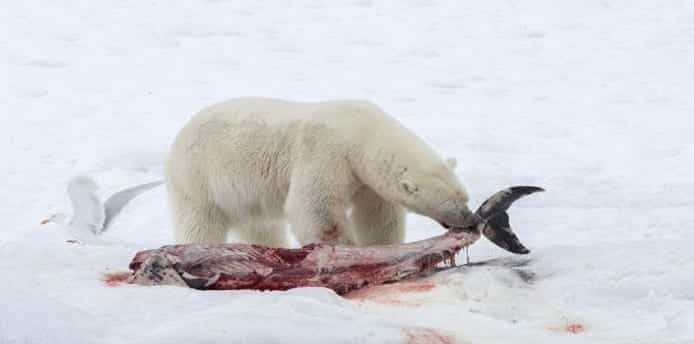Table Of Contents
For the first time, scientists have observed polar bears devouring white-beaked dolphins in the Arctic due to global warming.
Frozen dolphin carcass could provide a large source of food for the polar bears as climate change impacts their habitat
As the Arctic warms up, and the ice starts to melt, the polar bears are adapting to the changing environment. For the first time a polar bear was seen feasting on a white- beaked dolphin’s body in Svalbard.
Dolphins do not typically go that far up in the Arctic Ocean as they normally prefer to stay in the subarctic region with less ice and more open water.The researchers said in a commentary published online on June 1st in the journal Polar Research that in April 2014, a male polar bear with a full belly was seen near a recently devoured white-beaked dolphin, which could have weighed 120 to 680 lbs (54 to 308 kilograms) and measured 5 to 9 feet long (1.5 to 2.7 meters). The bear was also seen with another white-beaked dolphin’s thawing remains, which he was likely saving for a later meal.
The dolphins were generally trapped from the oval-shaped holes that they had kept open to breath. “We were surprised, as we did not think that we would notice dolphins in that area during that time of a year. Earlier polar bears were not recorded taking or eating dolphins,” Aars told Live Science in an email. “We were not so surprised of bears being able to take dolphins, known the dolphins were there.” He noted that polar bears are also known to consume belugas and narwhals, both of which are larger than the dolphins.
According to study in the journal Geophysical Research Letters, the surface water temperature of the Arctic Ocean near Svalbard has increased considerably over the past 45 years, leading to decreases in summer sea-ice cover over the entire Arctic Ocean and extreme melting during the year 2007.
The dolphins mostly make their way when the ice melts, however they are trapped when strong northerly wind packed drift ice onto the fjords, the researchers speculated. Similar dolphin entrapment has been recorded off the coast of Newfoundland as reported in studies in 1957 and 1996.
The researchers concluded that frozen dolphin body could provide a large source of food for the polar bears due to which they may lose contact to their normal meals of ringed and bearded seals as climate change impacts their habitat. At least seven different white-beaked dolphin skeletons were found in the same area during the ice-free summer and autumn following the first April siting. Aars said, “With longer periods without sea ice, bears will look for other food sources.
Adult male polar bears can weigh 775 to 1,300 lbs. (350 to 590 kg), and female polar bears can weigh around 330 to 650 lbs. (150 to 295 kg). When standing on all fours, polar bears are between 3.5 and 5 feet (1 to 1.5 m) tall; an adult male can tower at 10 feet (3 m) when standing on its hind legs.


